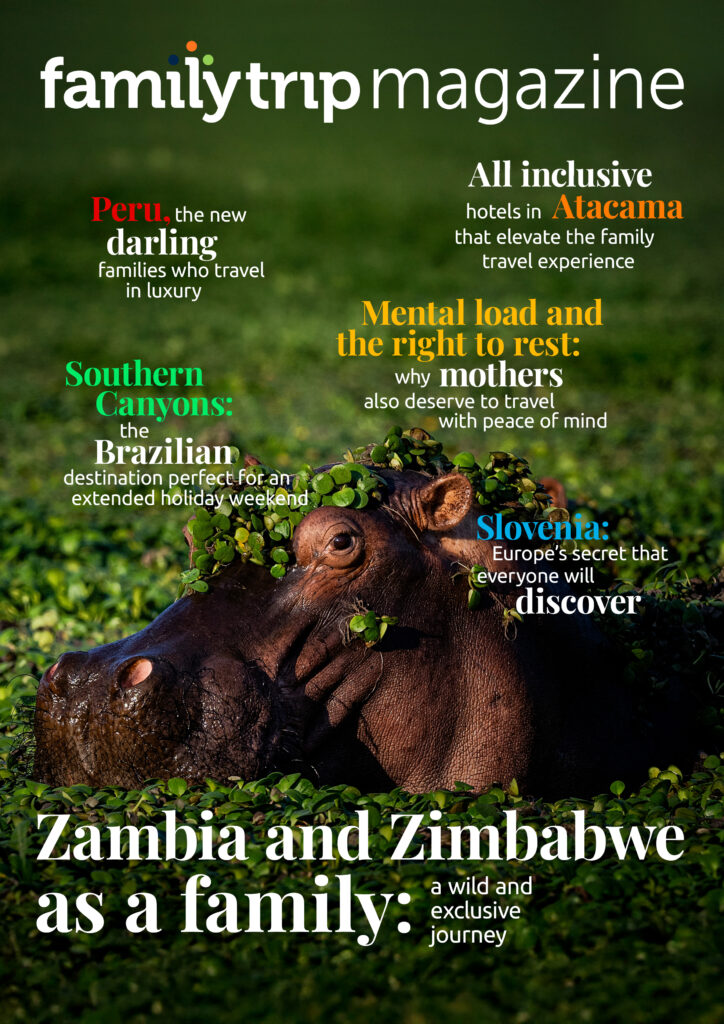
- Gastronomy
How to travel can help expand children’s palates
Tips to encourage children to try new flavors without pressure or stress, making the travel experience pleasant and enriching for the whole family
By Natália Faria G. Viana
Traveling with family is an excellent opportunity to experience new cultures and discover different flavors. Besides strengthening family bonds, these trips allow children to explore the world through cuisine, one of the most authentic expressions of any culture. However, adapting eating habits can be a challenge for little ones, especially when facing unknown flavors and textures.
Child palate specialist psychologist Leann Birch, a researcher at the University of Georgia, states that there’s a biological reason why children prefer salty, sweet, and fatty foods. “They’re born preferring salty and sweet, and if these flavors are in foods, most children will be very attracted to them,” says Birch, who has studied child eating behavior for more than four decades. She explains that parents should expect their children to initially reject new foods, an innate response called neophobia.
Food neophobia, which is children’s resistance to new foods, has evolutionary roots. According to a study published by Białek-Dratwa et al. in 2022 in the journal Nutrients, children’s taste buds are biologically adapted to prefer sweet flavors, avoiding bitter and sour ones that, in nature, may be associated with poisonous foods. This food neophobia behavior was advantageous in human evolution, increasing survival chances by avoiding ingestion of potentially dangerous substances.
But why insist that children try new flavors?
Birch clarifies: “If you repeatedly expose children to different flavors — including sour, bitter, and even spicy, but without forcing — they usually learn to eat a greater variety of foods.” Coming into contact with flavors from other cultures, therefore, despite being a challenge for many, is a valuable chance to expand little ones’ palates, making local gastronomy an enriching part of the trip for the whole family.
Birch emphasizes that exposing children to a diversity of flavors from early on “tends to produce children more willing to try other things.” She stresses that “babies are born predisposed to learn to eat the diets of people around them.” Ideally, according to Birch and other specialists, all children should eat the same as their parents from when they start ingesting solid foods, initially adapted for their age.
Thus, we can assume that families who travel to destinations with gastronomy different from that of their place of origin increase the chances of their children developing a broader palate. These exotic culinary experiences promote more diversified and healthy eating and enrich children’s cultural understanding, making them more open and adaptable to new experiences throughout life. Traveling, therefore, goes beyond discovering new places; it’s an opportunity for continuous growth and learning for the entire family.
Encouraging experimentation with new flavors during travel
A practical approach to encouraging children to try local gastronomy can be visiting restaurants a little before the usual mealtime. This offers the opportunity to try small portions of local dishes without the pressure of having to accept these foods as the only available option. Birch emphasizes that creating a positive environment during meals is crucial for developing a healthy relationship with food.
For older children, explaining the importance of being open to new seasonings and textures when discovering other cultures is usually an effective strategy. Involving children in choosing dishes or allowing them to observe food preparation tends to increase their interest. Jennifer Anderson, child nutrition specialist and creator of the “Kids Eat in Color” program, emphasizes that involving children in the process of choosing and preparing foods can increase their willingness to try new flavors.
Avoiding turning meals into moments of conflict and stress is also fundamental. Dr. Carlos González, pediatrician and author of the book “My Child Won’t Eat: How to Prevent & Solve the Problem,” states that respecting children’s hunger and satiety signals and not forcing them to eat are essential practices for creating a positive eating experience. This promotes a more collaborative and balanced environment, where responsibilities are divided more fairly.
Transforming eating into an adventure
Children tend to demonstrate personality and desire for control through food. Pediatric neurologist Ena Andrews advises not to bargain or fight, but rather transform resistance into desire for adventure. Challenge the child to try new things, convincing them they’re brave kitchen adventurers. David Ludwig, author of “You Need to Eat Better,” suggests involving the child in the food selection process, researching together online, explaining what’s healthy and why, and inviting them to cook together, like in a mini “Master Chef.”
Practical tips for expanding children’s palates
- Introduce new foods gradually: Offer small amounts of new foods along with familiar foods. Leann Birch emphasizes that repetition is key, as children may need to be exposed to a new food 10 to 15 times before accepting it.
- Be an example: Children tend to imitate adults. Showing enthusiasm when trying new dishes can encourage them to do the same. According to Ellyn Satter, parents who eat a variety of foods in front of children help normalize food diversity.
- Create stories around foods: Transform meals into adventures, telling stories about ingredient origins and the location’s culinary traditions. Jennifer Anderson suggests that involving children’s imagination can make the experience more exciting and less intimidating.
- Use non-food rewards: Praise and encourage the child for trying something new, but avoid using desserts as rewards. Dr. Carlos González emphasizes that praise and recognition can be effective motivators without creating negative associations with eating.
Incorporating these strategies can transform travel gastronomic experiences into moments of learning and pleasure for children. With patience and creativity, parents can help their children develop a more diversified palate, enriching their life experiences and strengthening family bonds.
References
– Białek-Dratwa A, Szczepańska E, Szymańska D, Grajek M, Krupa-Kotara K, Kowalski O. Neophobia-A Natural Developmental Stage or Feeding Difficulties for Children? Nutrients. 2022 Apr 6;14(7):1521. doi: 10.3390/nu14071521. PMID: 35406134; PMCID: PMC9002550.
– Satter, E. (2000). Child of Mine: Feeding with Love and Good Sense. Bull Publishing Company.
– Anderson, J. (2020). Kids Eat in Color: A Simple Guide to Raising Healthy Eaters. Healthy Eater Publications.
– González, C. (2006). My Child Won’t Eat: How to Prevent & Solve the Problem. La Leche League International.
– Ludwig, D. (2009). Você Precisa Comer Melhor. Ed. Bestseller.
Things the Way Family love to pack in their suitcase:
Gate
Eletronics for the travel: smartphone, drone, câmera, charger,…
Destiny
UV clothes, bikinis, caps, diving goggles, snorkel mask and other accessories…

















